Lab & Equipments
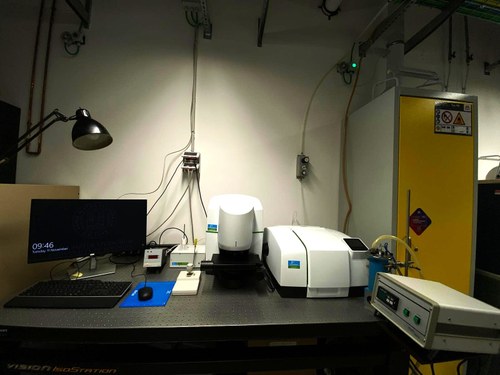
Micro-FTIR PerkinElmer Spectrum III dual range + spotlight 200i
(iEntrance facility)
FTIR spectrometer dual range, far- and mid-infrared, interfaced with microscope spanning from 30 to 8300 cm-1. The optical bench can work with ATR (diamond crystal) or in transmission mode a in the range 77 - 450 K coupled with the a variable temperature cell holder cell (KBr windows for mid-IR and Polyethylene for far-IR). The microscope is equipped with MCT liquid nitrogen cooled detector that allow to collect data in transmission, reflection and micro-ATR (Ge crystal) configurations. The microscope is coupled with Linkam stages for Temperature dependence (77-750 K) measurements in gas pressure (up to 14 bar). The stage has 4 probes for electrical measurements in situ and/or in operando conditions. The maximum spatial resolution can reach 5.6 microns depending on the spectral range.
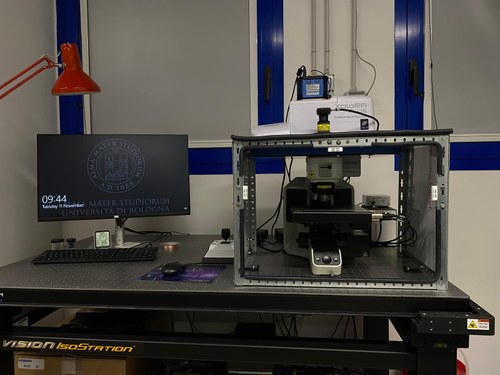
Micro-Raman Horiba Xplora Plus
(iEntrance facility)
Micro-Raman spectrometer equipped with dual excitation lasers, 532 and 785 nm, 5 objectives (5, 10, 20 SLWD, 50 SLWD and 100 X) reaching a spatial resolution up to 500 nm and with edge filters which allow a spectral range up to 50 cm-1 from the Rayleigh line. The spectrometer is interfaced with a microscope with x, y, z motorized stage for Raman mapping and imaging. The setup is coupled with is a CCD Peltier cooled (-60° C) detector ranging from 200 to 1100 nm.
The microscope is coupled with Linkam stages for Temperature dependence (77-750 K) measurements in gas pressure (up to 14 bar). The stage has 4 probes for electrical measurements in situ and/or in operando conditions.
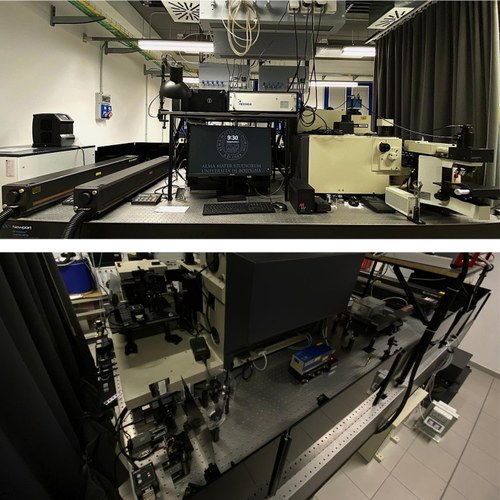
Horiba Jobin Yvon T64000 triple monochromator micro-Raman
(iEntrance facility)
Triple grating spectrometer interfaced with Olympus BX40 optical microscope equipped with 5x, 10x, 20x LD, 50x and 100x objectives. The experimental setup is provided with an Argon ion gas laser (488 and 514,5 nm), a Krypton ion gas laser (568, 647.1, 676.4, 752.5 and 799 nm) and a diode laser tuned at 785 nm with a total of 8 different excitation wavelengths. The spectrometer can work in triple additive mode reaching a maximum spectral resolution of 0.04 cm-1 or in double subtractive + additive mode with the possibility to scan the low frequency range (THz region) up to 5 cm-1. The combination of the highest energy excitation (488 nm) and the highest magnification objective allow for a maximum lateral resolution of about 400 nm. The spectrometer is interfaced with a microscope with x, y motorized stage for Raman mapping and imaging. The setup is coupled with is a CCD Peltier cooled (-60° C) detector ranging from 200 to 1100 nm.
The microscope is coupled with Linkam stages for Temperature dependence (77-750 K) measurements in gas pressure (up to 14 bar). The stage has 4 probes for electrical measurements in situ and/or in operando conditions.

Confocal Laser Scanning Microscope Zeiss 710 (micro-PL/Abs)
The Zeiss LSM 710 confocal microscope system uses a Zeiss AXIO microscope stand with transmitted, reflected (HAL) and laser illumination sources. It can collect transmitted light images (bright field and DIC) as well as conventional and confocal fluorescence images. The scope has 10x, 20x, 50x and 63x objectives and used as excitation a 405 nm Diode laser in confocal mode. ZEN 2011 software is used to control the microscope, scanning, laser module, tools and the image acquisition and processing. The microscope has been updated using a in-house setup to collect micro-Photoluminescence and micro-Absorption in specular reflection configuration. The excitation for micro-Pl is achieved by LED tuned at 365, 395, 450, 560 and 650 nm while the absorption in specular reflection by illuminating with halogen lamp which cover the spectral range from 350 to 700 nm. The signal is collected by Hyperspectral camera HERA VNIR from NIREOS. HERA camera is based on a Fourier Transform (FT) approach: the data-cube is acquired in the time-domain, by step-scanning a compact ultra-stable interferometer in front of the CMOS sensor. The software HyperLab automatically computes an FT at each and every pixel of the image, providing the final hyperspectral data-cube.
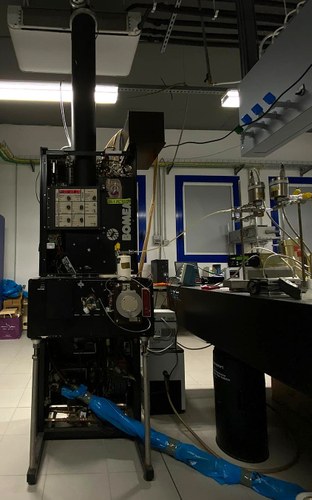
High Resolution FTIR Bomem DA3 & DA8
(iEntrance facility)
In our laboratory there are two high-resolution Fourier transform BOMEM spectrometers. The maximum resolution attainable is 0.004 cm-1. The total spectral range that can be covered goes from 10 to about 13000 cm-1 with different detectors, beamsplitters and sources.
There are two room-temperature multipass cells for gaseous samples with a variable pathlength up to 10 m. Two cells with a fixed pathlength of 16 cm, one operating at room temperature and one that can be cooled down to about 170 K.
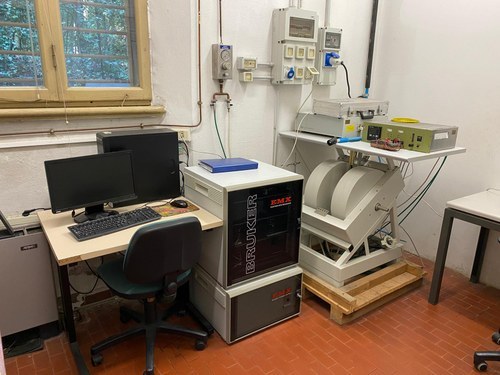
EPR Bruker X-Band
The Bruker EMX is a CW X-Band (9-10 GHz) EPR spectrometer with a 0-600 mT electromagnet. It has liquid nitrogen (100-300 K) variable temperature capabilities.
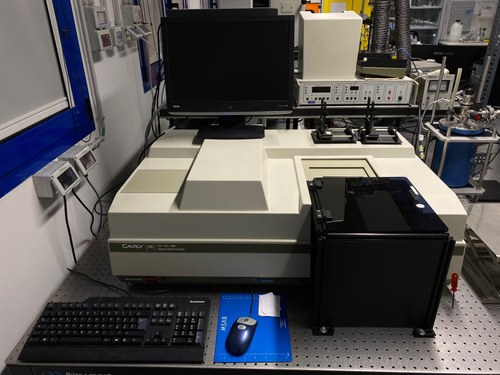
Cary 5E UV-VIS-NIR
The Cary 5E spectrophotometer (Varian) is an instrument covering a wide wavelength range (200-3200 nm), from UltraViolet (UV), visible (Vis) to Near InfraRed (NIR). Since it is equipped with a double monochromator, the amount of stray light is negligible thus allowing for the measurements of even high absorbing samples (up to around 5 absorbance units) or very diluted solutions. It has as an accessory for specular reflectance measurements.
The instrument setup has been modified to allow the coupling with hot and cold stage for measurements in trasmission as a function of T from -190 C and up to 600 C.
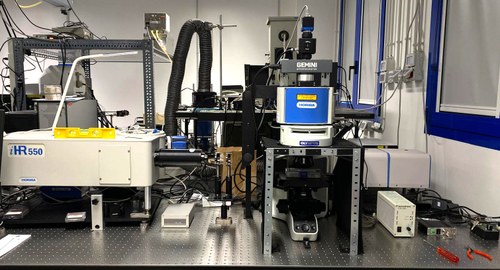
MicroRaman/MicroPL-Abs (Standard Microscope Spectroscopy Systems – SMS)
A custom built setup for micro-Raman mapping and hyperspectral imaging of photoluminescence and absorption in specular reflection at the same spot and size. The excitation and the collection of the light is by an Olympus BX53 microscope equipped with 5 different objectives (10, 10IR, 40, 60 ,100X) and a motorized xyz stage. The micro-Raman use 514.5 and 785 nm excitation laser and the signal is analyzed with a 550 mm spectrometer equipped with 3 gratings (600, 1200, 1800 gr/mm) and a CCD detector peltier cooled at -60 °C (HORIBA). The excitation for microPL is provided by LED sources tuned at 365, 395, 450, 560 and 650 nm and the microAbs in specular reflection by exciting with a broadband light with emission from 340 and 1800 nm. The Hyperspectral imaging for microPL/Abs is obtained by Gemini interferometer from NIREOS working in the range 400-1700 nm.
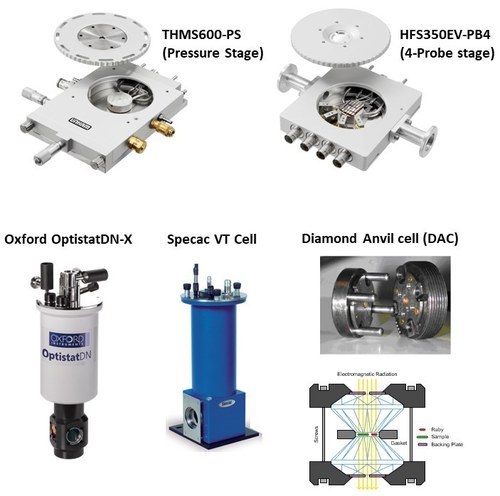
Variable temperature and high pressure cells
In our lab we have several accessories for measurements at variable Temperature, at controlled atmosphere and under High Pressure:
-The THMS600-PS can be used to investigate the effects of pressure on the sample during heating and cooling experiments (-192°C to 600°C) by pressurising the sample chamber up to 14bar. Pressurising the sample can be also used to minimize sample evaporation and sublimation.
-The HFS350EV-PB4 enables electrical measurements on the sample, while accurately controlling the temperature (temperature range from < -195°C to 350°C) , by 4 positional probes.
-Oxford Optistat cryostat, for a wide range of spectroscopy applications. Suitable for UV/VIS, Raman, FTIR, Fluorescence, Photoluminescence, Micro-PL, Terahertz, Microscopy and Electroluminescence measurements up to liquid nitrogen T (77 K).
-Specac VT cell ( Variable Temperature Cell Holder) is an accessory to use for the transmission study of liquid or solid samples at various temperatures ranging from -190 ºC to 250 ºC. Equipped with KBr and PE (Polyethylene) windows can be used from FIR, MIR and NIR ranges.
-Diamond anvil cell (DAC) home made and commercial ones for High pressure spectroscopy.